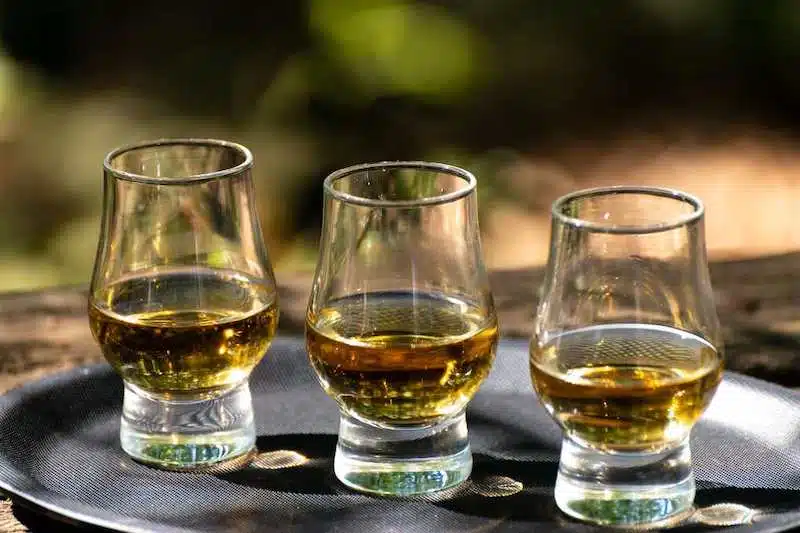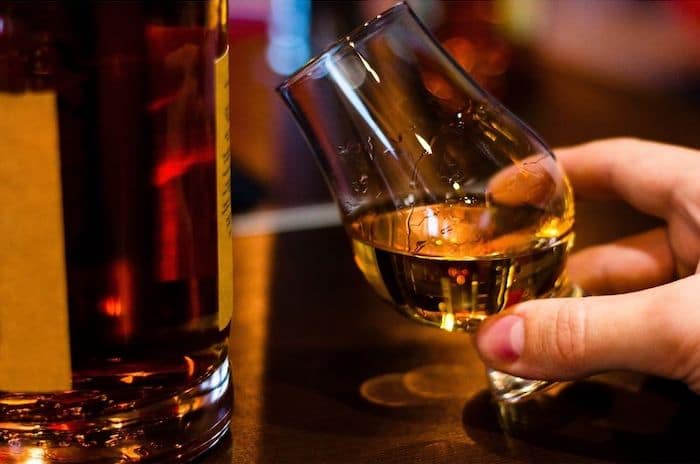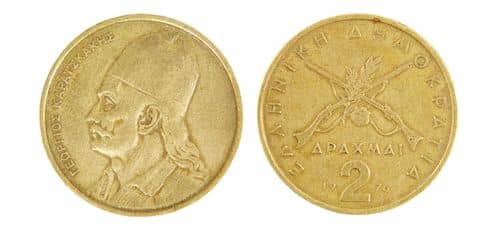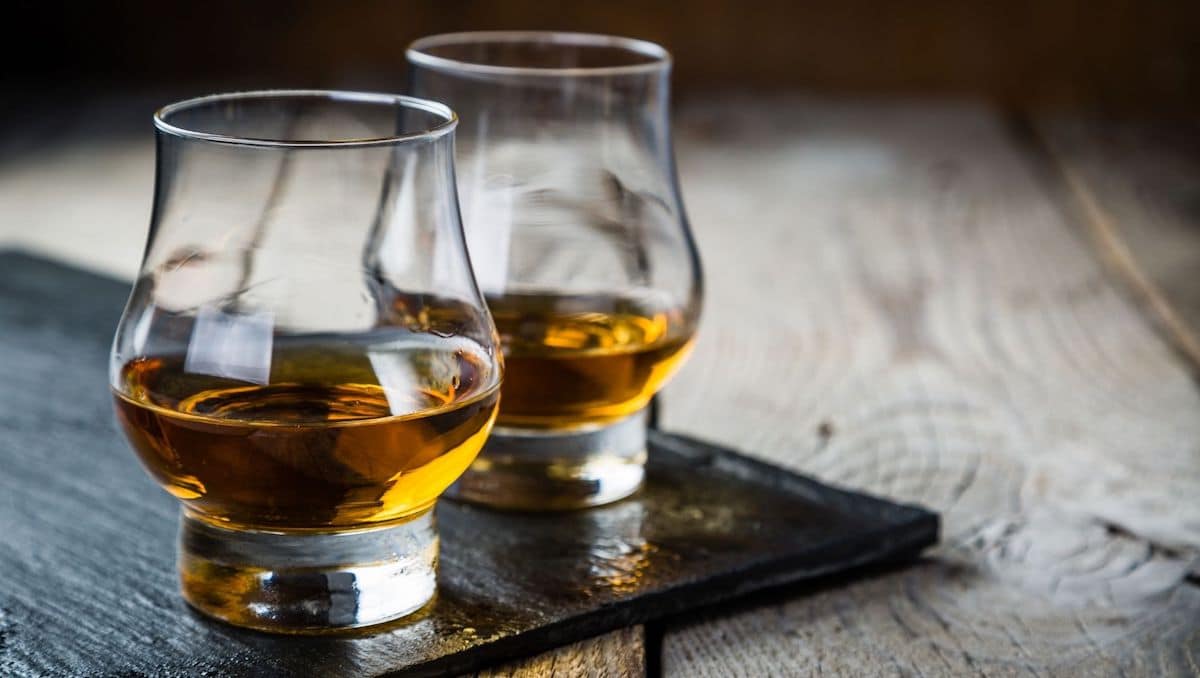A dram of whiskey equals one-eighth of a fluid ounce (3.7ml), less than one teaspoon (5ml). That means a regular serve of whiskey (1.5 ounces) contains about 12 drams. But that's not what you get when you order a dram of whiskey in a bar. In Ireland, you get 35.5ml, in the UK between 25ml and 35ml, and in the US you typically get 45ml or 1.5 fluid ounces.
The term dram originates from Scotland and is a synonym for one serving of whiskey. However, a dram of whiskey is a very flexible unit to measure the amount of liquid.
Initially, it referred to a small amount, less than 5ml: 3.69ml or 1/8 of a fluid ounce. However, in daily use, that would be pretty impractical. Today, ordering a dram of whiskey will get you way more than that. How much depends on the region and your bartender.
What is a Dram of Whiskey?

We previously established that a dram is a unit of measurement that equals 1/8 of a liquid ounce or 3.7 milliliters. The official definition of the word is a bit looser.
Renowned English dictionaries like the one from Cambridge define a dram as a small amount of a strong alcoholic drink. While that is pretty much what it is, it leaves a lot of room for interpretation.
In real life, the term dram stands for one serving of whiskey. The size of said serving depends on the country and the bartender. Some values serve as orientation, but most bartenders measure the measure dram with feeling and eye and not with a measuring cup or jigger.
How is a Dram Measured?
You can measure a dram with the help of the United States Customary System or the guidelines of the UK National Measurement and Regulation Office.
The United States Customary System measures units in foot, miles, pounds, inches, and ounces. In this system, one dram represents one-eighth of a fluid ounce.
The UK National Measurement and Regulation Office uses the metric system to measure units, like kilometers, kilograms, and milliliters. The switch to the metric system in the UK, however, did not occur until the 1970s; before that, standard beverage sizes were measured in gills.
A quarter gill was a common size for spirits, especially in Scotland and Ireland. In Ireland, therefore, the drama is still a quarter gill. In the rest of the UK, measurements changed, and today a dram size of 25ml to 35ml is common.
Whiskey Drams - Types & Sizes
The size of a dram of whiskey may vary depending on location. Here are some of the most common dram sizes around the world.
Irish Dram
As the UK and Ireland adopted the metric system in the 70s, the measures were standardized and converted to milliliters.
Ireland decided to stick to 1/4 imperial gill (English measure for one-fourth of an imperial pint, not to be confused with the US Gill), converted to 35.5ml as standard dram.
UK Dram
In the UK, it's up to the pub or bartender to choose between serving 25 or 35ml per dram.
Scottish Dram
The Scots started ordering their whisky by the dram. It always had been an unofficial measurement, best described as the amount of whisky you can swallow at once.
However, in most cases, the size of one dram equals the amount of the UK dram, as both are the UK National Measurement and Regulation Office. That means you either get 25ml or 35ml when ordering a dram in a Scottish bar.
US Dram
The American dram holds even more than the Irish and evidently adjusted to the alleged fact that Americans like their drinks in larger sizes. Thus, in the United States, ordering a dram usually gets you 1.5 oz of whiskey - that is just short of 45ml.
Wee Dram
The term "wee" stands for small or little, and in the context of dram, it simply describes a smaller-than-usual serving without being too precise in terms of measurements.
Dram sizes in other countries
Ordering a dram of whiskey in Germany can get you a serving of 20ml or 40ml. Most of the time this will be 40ml, but you can't be sure unless it says so on the menu.
Ordering a dram of whiskey in France will most certainly get you a serving of 30ml. And the list goes on.
There are different amounts for almost every country. And that is not exactly making it easier to understand the dram size. Read on to learn how the various measurements came about.
So, what does dramming mean?
Dramming describes the act of drinking a dram, mostly in company. For most of us, dramming in company tends to be on the stiffer edge. - And even a wee dram (wee means a little in Scotland and Ireland) can turn out quite a lot when dramming with your best friends.
When you pour for yourself, a dram is just the amount of whiskey you feel comfortable with at a given time. You see, that may vary.
Therefore the Scottish are using some additional terms to specify the amount further: The size ranges from a wee dram over a healthy dram to a stiff dram.

Evolution of the dram in the British measurement system
The Brits could have left it at the free interpretation of a dram. However, while this certainly makes sense when poured at home, it does not so much when you intend to sell whiskey by the dram. Then you will need a more precise definition.
Dram, as a unit of measurement, exists in two ways. One is a weight measure, the other the fluid dram we know from drinking whiskey. It initially equaled the above-mentioned 1/8 oz of the spirit.
However, as mentioned briefly, the British Empire decided that from 1973 on, the Anglo-American measurement system should gradually be replaced by the metric system, making a dram of 3.55ml and a hard thing to measure with the new system.
In this case, dramming would not have been much fun, as this is barely enough whiskey to moisten our tongue. So adjustment was inevitable.
To understand that, we introduce another measure: the unit of choice in British pubs once was gill. A gill is the same as a quarter pint (568.26 ml) - too small for a beer and too much for a high-proof liquor.
Therefore, spirits got served in quantities like 1/6, 1/5, or 1/4 of a gill. That converted to shots with 23.7ml, 28,4ml, and 35.5ml. So over time, these common parts of a gill were often called a dram.
So the size of a dram still varied regionally, but now there was a smaller range. As a rule of thumb, you can apply the Distance to London rule: The further away from London, the more whiskey a dram.
History of the Word Dram
Dram - a term for a weight measure - originates from the ancient Greek term Drachma. A Drachma had been the currency, a coin, actually, of Greece until 2002. Then it was replaced by the Euro.

Its Latin translation Dragma was adopted by the French and continued the journey from there into English-speaking countries. That was when it became a dram and was used to measure the physical weight of objects.
Conclusion
Even though a dram is now somewhat standardized for pubs and restaurants, it still widely varies for private events or whiskey distillery tours. Some serve less, some more.
By the way, should you be looking for distillery tours serving drams on the stiff end of the scale, I recommend visiting distilleries on Islay and getting into good graces with the guide. Because, as a Scottish quote says:
"A dram is a measure of Scotch determined only by the generosity of the pourer.”

